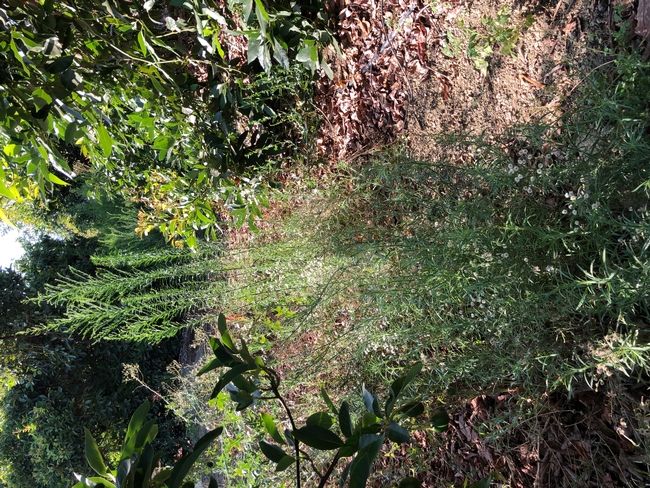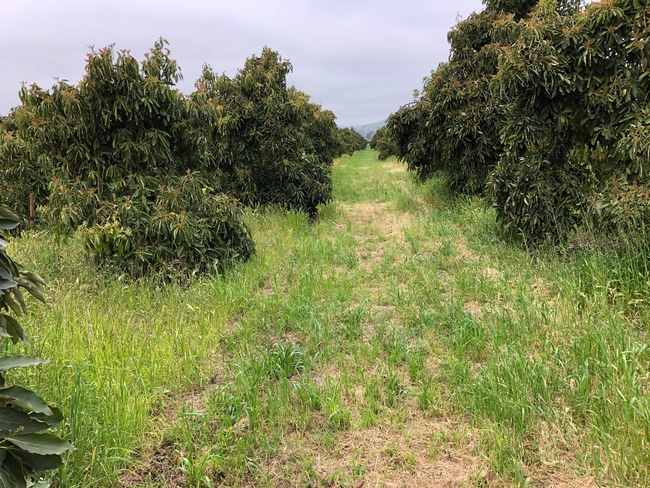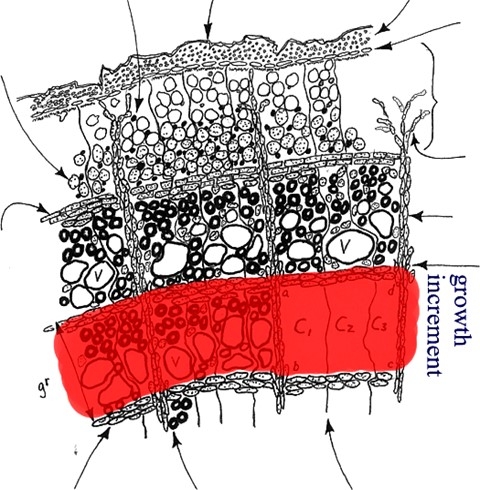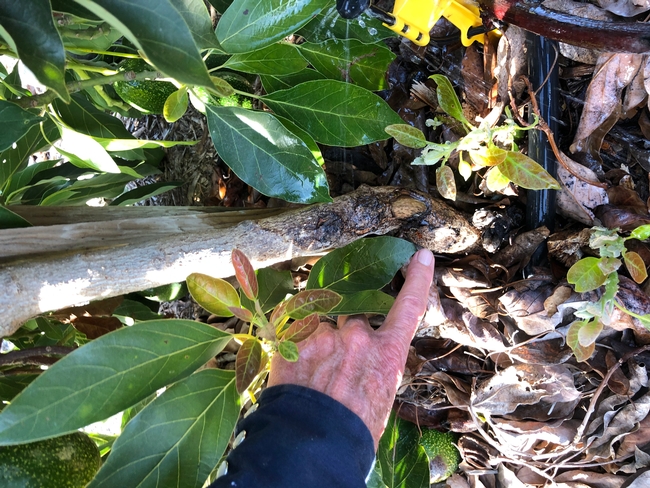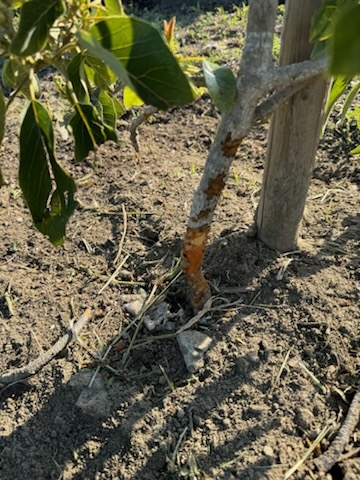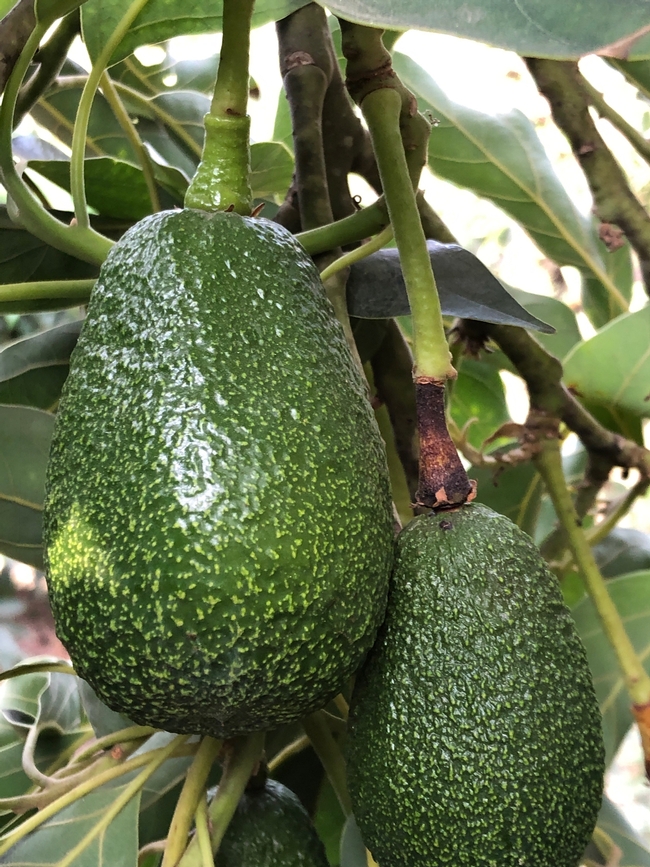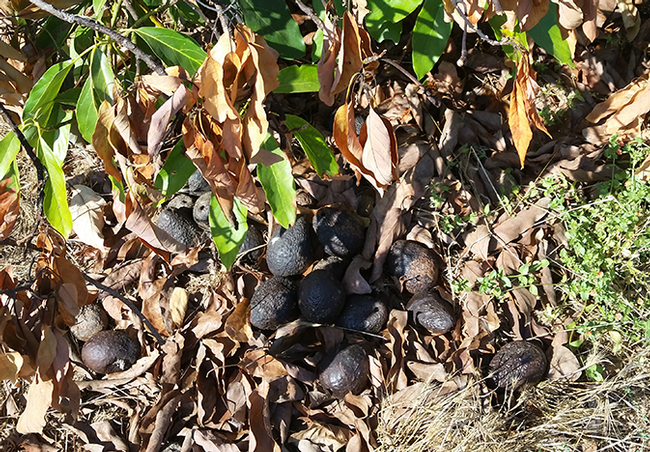
Posts Tagged: damage
Weed B Gone and Tree B Gone?
With all the rain last year, even extending into August and now with the rains since December there is a lot of natural ground cover growing, When it gets out of hand, we call it weedy. It might still serve the purpose of protecting the ground from erosion, but it can become an impenetrable mess and if allowed to go into summer, a major fire hazard. In the case of some young orchard, the malva and mustard is bigger than the trees themselves. Getting control of them before they get woody and go to seed is easier earlier than later. So it's time to do something about them if you haven't done so already.
A common practice on flat ground is to mow the middles and then weed whack/whip the tree row up to and around the tree trunk. In the case of trees that have their canopies down to the ground or near the ground or that have created a thick leaf mulch, there's not usually much weedy growth near the trunk. Then weed whacking around the canopy is not much of a problem. If on a slope like most avocados, it's a big, expensive, laborious, hot, sweaty, arduous process of weed whacking. Just waiting long enough for the leaf mulch to create a barrier to weed growth and for the canopies to grow out to rob the sun from the surface undergrowth.
In young trees without a large canopy, it can be a really difficult process of getting those weeds near the trunk. Care must be taken to avoid damage to the trunk. In a couple of recent examples, weed whacking got right up and on the trunks and significant damage was done to the trees. When a wound occurs in any tree, a process kicks in to generate tissue to cover the wound, much like what happens with humans and wound cuts. There's a scar left, but it heals over. If the wound is too large, many trees cant cover the woody tissue fast enough. The wood beneath the cambium ( the green tissue below the bark) is prone to fungal infection and eventually the fungus eats away at the interior of the tree. If the wound is large enough and girdles the tree, all the nutrients from the leaves feeding the roots is cut off. The photosynthate sugars that keep the roots functioning, and the roots stop doing what roots do. This is absolutely true is citrus and most other orchard tree crops. But not avocado.
When making a cross section of most trees, it's possible to see the growth rings – the growth increments that appear each year. The tree starts and stops growth each year and it's possible to clearly identified in what year there was more or less growth. In long lived trees like redwood, it's possible to identify years when certain events happened – the year of Lincoln's Gettysburg Address, for example. This growth habit is called ring porous.
In the case of avocado, it has a growth habit called diffuse porous. There is growth throughout the year and the rings are nor clearly delineated, if at all. It's because of this possible active growth occurring, that the avocado can often cover over damage that is quite extensive. After a fire, given time, mature avocado trees can summon up energy to recover to a great extent. It's not so true of young trees, however. Avocados still have a greater regenerative capacity than a lemon tree, and if the damage is to just one side of the tree, there's a very good chance of recovery.
But these young tree are severely impaired. They do have a chance of recovery, but the damage is extensive and the trunk is fully girdled. Only time will tell if they do recover. If the tree were only a year old, it would be a good idea to pull them and start over. But a number of these trees are three years old and have had a lot of investment in them besides their initial nursery cost – pruning, weeding, irrigation, fertilization, etc. It is heart breaking to see damage like this after so much attention has been paid to them.
And the best thing is to let the tree recover on its own. Use of pruning paint actually impairs tissue regeneration. The grower asked if a kaolin protectant like Surround might be used to provide some sun protection. Since that breathes, it might be a good idea. It might also be a good idea to apply some trunk wraps. These were taken off in order to prevent earwig and snail harbor which can cause significant damage to young trees. But they also provide protection from overly aggressive weed whackers. It is always a compromise when making these decisions.
Avocados Get Hot
If you see significant leaf drop in your groves due to excessive heat, the following actions are recommended:
- As soon as possible, whitewash branches exposed to the sun with special attention paid to branches on the west and south sides of the tree.
- Trees that lose a significant portion of leaves cannot efficiently move water, therefore restrict irrigation amounts to ensure you avoid creating wet, soggy conditions that can lead to root rot. It's best to irrigate less frequently and with smaller amounts of water.
- Do not prune your trees — leave hanging leaves in place to protect the tree from sunburn. Once new tree growth has occurred (in the next 3 – 6 months), pruning can take place on living wood.
- Adjust fertilization as you would with a frost-damaged tree: reducing the amount of fertilizer until the tree is re-established. If you see signs of a particular nutrient deficiency, adjust fertilization accordingly.
For more information about managing heat in avocado groves, growers can view the following articles on the California avocado growers' website:

heat damage gem avop
Invasive Goldspotted Borer Hits California Oaks
By Julie Clark, Community Education Specialist III
Goldspotted borer (GSOB) is a beetle invasive to oaks in California. Infestations have ravaged oak woodlands in San Diego and Riverside counties the last 12 years and in Anaheim Hills, Angeles and San Bernardino National Forests the last few years. Preferred hosts are black oak, canyon oak, coast live oak, and occasionally Engelmann oak.
Oak woodlands are highly valued ecosystems that support numerous species of fauna. Oak trees serve as the anchor for these systems and support over 5000 insect species, over 105 bird species, 105 mammal species, 58 species of amphibians and reptiles during their respective life cycles. Many beneficial insects rely on oaks to complete their life cycles and do not damage the trees in doing so.
GSOB bore into the bark of its hosts to lay eggs and rear young. Mature beetles emerge to find new hosts. The adults leave a distinctive D-shape hole in the bark upon exit. 
The insects damage the water and food transfer structures (xylem and phloem) of the tree, causing crown die-back and eventual death in heavily infested (amplifier) trees. Widespread loss of oaks from GSOB has occurred in Idyllwild and San Diego County mountain areas.
Although GSOB are winged, they do not fly long distance. UC researchers, partners with CAL FIRE and the California Firewood Task Force discovered that several of the infestations throughout Southern California were caused by introduction of firewood imported from infestations in other areas. 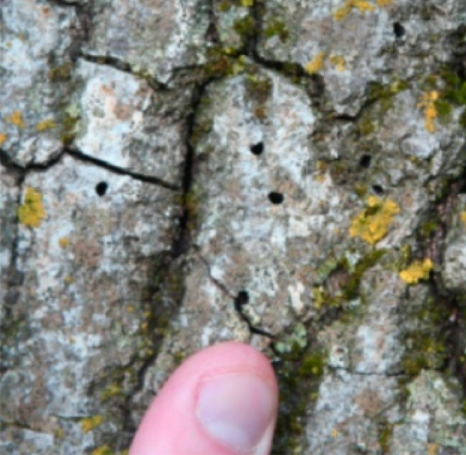
D-shaped GSOB exit holes. Credit: UC ANR
Ventura County is vulnerable to attack by the beetle and other invasive tree pests that are on watchlists for the area. Best ways of being assured your firewood is safe include purchasing locally source material or selecting kiln-dried or certified firewood.
For more information:
Report suspected GSOB infestation:
https://ucanr.edu/sites/gsobinfo/What_You_Can_Do/Report_GSOB_Symptoms/
Heat Mitigation Around the World - Avocado
Heat Mitigation Around the World
A chance to hear what can and is being done by growers
to reduce the damage inflicted on avocado fruit and trees
World wide Speakers:
Click here for the June Seminar/Webinar Recording

heat damage to avocado leaves

Heat damaged young avocado fruit

heat damaged young avocdo tree
Frost and Frost Protection
You wanted to know all about Frost, well it's all here. Emeritus Rick Snyder put it together over the years and it's at your finger tips.
English Frost Protection Training Units (videos)
Spanish Frost Protection Training Units (videos)
When to Turn Sprinklers On and Off for Frost Protection
FP001 Quick Answer—This quick answer provides information on using a psychrometer or temperature and dew point data to determine when to start and start sprinklers for frost protection.
Predicting Temperature Trends during Freeze Nights
FP002 Quick Answer—This quick answer gives a method for predicting the change in
temperature during a calm, radiation freeze night.
A Simple Method to Measure the Dew Point Temperature
FP003 Quick Answer—This quick answer provides information on how to measure the dew point for use in estimating minimum temperature and for starting and stopping
sprinklers for frost protection.
Sprinkler Application Rates for Freeze Protection
FP004 Quick Answer—This quick answer provides information on the sprinkler
application (precipitation) rates needed to protect crops from freezing.
Principles of Frost Protection
Frost Protection Training Units (videos) on measuring temperature, frost protection with water, frost protection with wind machines, and passive protection. Traning units are availble in English and Spanish .
FP005 Quick Answer—This quick answer provides information on the general principles of well-known frost protection methods. A PDF file of the WEB page can be uploaded from this Quick Answer. In addition, a shorter version is available.
Programs for Estimating Frost Night Minimum Temperatures and Temperature Trends (new 7 Mar 2007)
The FFST Excel application programs FFST_E.xls and FFST_M.xls are available from this link. The FFST application helps users to determine an empirical equation for estimating minimum temperatures during radiation frost nights. Note that the program will provide good estimates if there is little or no wind, no significant cold air drainage, and no clouds.
The FTrend Excel application programs FTrend_E.xls and FTrend_M.xls are available from this link. The FTrend application program is used for estimating changes in air and wet-bulb temperatures during a frost night. The application is useful for predicting when to start sprinklers for frost protection and for other methods as well.
Estimating Risk of Frost Damage from Climate Data (new 8 Jul 2006)
One of the programs included with the book Frost protection: fundamentals, practice, and economics. Volume 2, which is available from the UN FAO is the Frisk program. Information on how to obtain the book is presented above on this web page. Based on reader feedback, some improvements have been made to the Frisk application since the book was published. Updated versions of the application are made available to the public here. The Frisk program is an MS Excel application that is designed to help growers to make decisions on the risk of frost damage in a particular location. The user inputs the local climate data and a critical damage temperature, and the application computes the probability of temperature falling below the critical temperature on each day of the year. These data are then used to estimate the length of the growing season relative to the critical temperature by presenting a graph of the probability that the growing season will be less than a specific number of days. The application also computes the certainty that no air temperature will fall below the critical damage temperature after a selected date in the spring or before a selected date in the fall for design periods of 5, 10, …, 30 years. This certainty of no events is equivalent to the risk of having one or more events during the same time period. Although Celsius temperature was used in the example application programs, the program works equally well using Fahrenheit temperature. To obtain a copy of the application, click on FriskNH.xls for the northern hemisphere or FriskSH.xls for the southern hemisphere. Note that metric units were used in the Frisk application sample data.
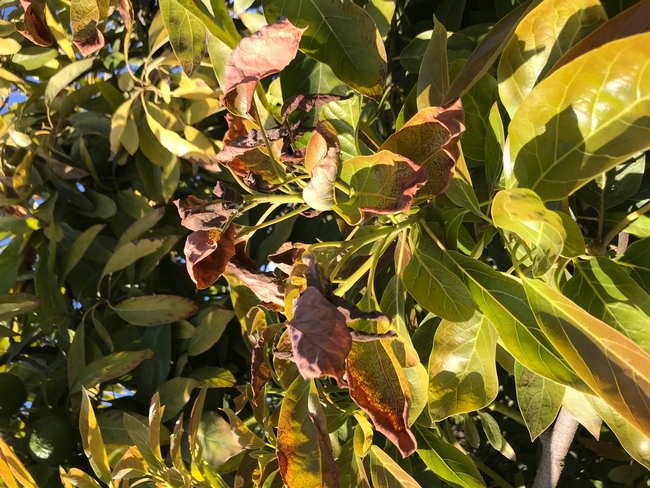
frost damage leaves

